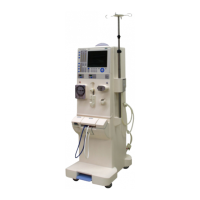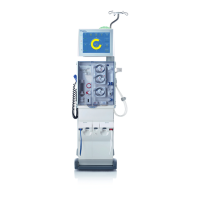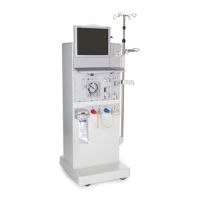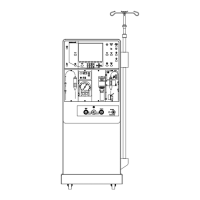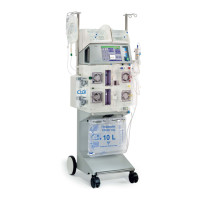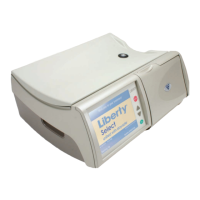8-160 Fresenius Medical Care 4008 4/09.03 (TM)
● Power failure recognition and battery connection
Since it must be possible to recognize a power failure, the secondary voltage of the standby
transformer is monitored. The pulsating DC voltage is directed to the Schmitt trigger IC 4, pin 9,
via diodes DI3, DI4, and the voltage divider R6, R7. Via IC6, pin 4, the 100-Hz square-wave signal
developing at the output of IC 4, pin 8, is applied to the reset input of the counter module IC 9, pin
11 (4040). The pulse width of the square-wave signal is designed such that only short-time LOW
pulses (approx. 3 ms wide) can develop at IC 9, pin 11; i.e. counter IC 9 is usually inhibited.
A 5-V square-wave signal with a frequency of 2 kHz is applied to pin 23 of plug X639A. After a
level conversion to 12 V (R62, T13, R63), this signal reaches the clock pulse input of the counter
module IC 9, pin 10, via several interposed gates. During the L level phase of the reset signal, the
counter IC 9, is counted up. Should this L level phase become impermissibly long because the
supply voltage is dropping or the power failing, the counter module IC 9, pin 3, achieves H level
after 8 ms. Via IC 6, pin 6, the reset signal for IC 9 is inhibited, the clock pulse separated from the
counter by means of IC 6, pin 12, and the condition thus stored. The H level, which is now applied
to X639A, pin 6, is a signal of power failure for the CPUs. Via IC 7, pin 8, the output signal of the
counter module IC 9, pin3, is directed to the gate IC 7, pin 12. There it is linked to the watchdog
signal of CPU 1, so that a H level is transmitted to T9 with the watchdog being intact only. T9 then
supplies the coil of the battery relay RL5 with current, and the contact 7/8 RL5 is closed. The
slide-in modules (24V_EM; X639A, pins 29, 39, 31) and both the 5-V and the 12-V switching
regulators (26V_UR; X639C A28) are supplied with the battery voltage via diodes D4 and D6.
As soon as IC 9, pin 3, has achieved H level, the square-wave signal, which is obtained from the
standby voltage (see above), is applied to the clock pulse input of counter IC 9, pin 10, via IC 6,
pin 9. After the power has returned, the counter is supplied with pulses by the square-wave signal,
thus starting to count up again. Since the counter frequency has decreased (100 Hz instead of 2
kHz), it takes 160 ms until IC 9, pin 3, turns to L level and the battery is separated from the circuit
again. This delayed switch-off and the rapid connection (8 ms) is intended to guarantee a smooth
transition between normal operation and standby operation. The L level at IC 9, pin 3, serves to
reestablish the initial situation (2-kHz pulse at IC 9, pin 3, and 100-Hz square-wave signal at IC 9,
pin 11).
● Battery test
In order to obtain information on the condition of the battery, it is briefly loaded during the T1 test.
The resultant battery voltage is read in.
By applying a H level to X639A, pin 10, a pulse of approx. 100 ms width is generated via the
differentiating network C39, R24 and the two gates (IC 4, pin 13; IC 7, pins 1 and 2). This pulse is
used as signal for activating the transistor T4. The battery is then loaded with a current of approx.
3 A by resistor R39.
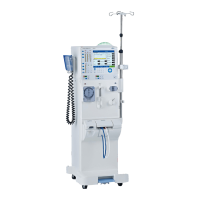
